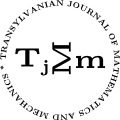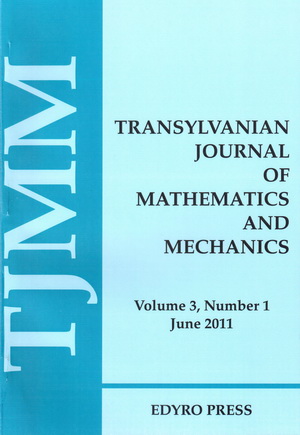Volume 6 (2014), Number 2
Hahn’s Problem with Respect to a Third-order Differential Operator
Author(s): BAGHDADI ALOUI
Abstract: In the present work, we are interested to the lowering operator , given by a Linear combination of three successive Laguerre derivatives where , (i.e. containing ordinary derivatives with respect to the variable), and is an arbitrary complex number. Then, we establish an intertwining relation between the operators and the standard derivative . Besides, an analogue to the Hahn problem for the operator is studied. As a consequence, some integral relations between the corresponding polynomials are deduced. Finally, some expansions in series of Laguerre polynomials are presented.
DownloadIntegrable Solutions for Implicit Fractional Order Differential Equations
Author(s): MOUFFAK BENCHOHRA and MOHAMMED SAID SOUID
Abstract: In this paper we study the existence of integrable solutions for initial value problem for fractional order implicit differential equations. Our results are based on Schauder’s fixed point theorem and the Banach contraction principle fixed point theorem.
DownloadSome Integral Operators of Analytic Functions
Author(s): RADU DIACONU
Abstract: In the present paper we define two integral operators and , defined using the differential operator . We introduce some classes defined by these operators and we investigate properties of the integral operators on these classes. Also, are obtained subordination results for functions associated with the differential operator .
DownloadSpace and Time Quantization. Particles with Spin 0
Author(s): LAUREAN HOMORODEAN
Abstract: The dynamical state of a particle with the spin 0 is described by a (4-dimensional) scalar wave function in the momentum representation. The time and the coordinates are associated with Hermitian linear operators acting on the wave functions. The eigenvalues and the eigenfunctions of the time and of the coordinates are determined by the wave equation. With its aid, we define the time-coordinate 4-tensor and the ”current density” 4-vector, which satisfy some ”conservation laws” and allow to write the time, the coordinates and the ”charge” as integrals of the components of these quantities in the momentum space. The expression of wave function in the second quantization leads to two kinds of particles: particles proper and antiparticles. We express the time, the coordinates and the ”charge” by creation and annihilation operators and determine their eigenvalues. Because the momentum is limited in value, the space and the time become discrete. Each position is populated with particles and antiparticles living a finite time. The changes in numbers of particles and antiparticles in different positions by creation and annihilation lead to displacement of the center of the particle system. This is interpreted as the macroscopic motion of a particle. Particularly, the strictly neutral particles are discussed.
DownloadSpace and Time Quantization. Particles with Spin 1/2
Author(s): LAUREAN HOMORODEAN
Abstract: The dynamical state of a particle with the spin 1/2 is described by a (4-dimensional) bispinor wave function in the momentum representation. The time and the coordinates are associated with Hermitian linear operators acting on the wave functions. The eigenvalues and the eigenfunctions of the time and of the coordinates are determined by the wave equation expressed in diverse forms. With its aid, we define the time, the coordinates and the “charge” of the particle field. The expression of wave function in the second quantization leads to two kinds of particles: particles proper and antiparticles. We express the time, the coordinates and the “charge” by creation and annihilation operators and determine their eigenvalues. Because the momentum is limited in value, the space and the time become discrete. Each position is populated with particles and antiparticles living a finite time. The changes in numbers of particles and antiparticles in different positions by creation and annihilation lead to displacement of the center of the particle system. This is interpreted as the macroscopic motion of a particle.
DownloadNew Ostrowski Type Inequalities for Co-ordinated -Convex Functions
Author(s): MUHAMMAD AMER LATIF
Abstract: In this paper, we establish some new Ostrowski type inequalities for functions of two variables whose derivatives in absolute value are co-ordinated -convex.
DownloadPositive Periodic Solutions for First-Order Nonlinear Neutral Functional Differential Equations with Periodic Delay
Author(s): MOUATAZ BILLAH MESMOULI, ABDELOUAHEB ARDJOUNI and AHCENE DJOUDI
Abstract: In this paper, we study the existence of positive periodic solutions of two classes for first-order nonlinear neutral functional differential equations with periodic delay. The main tool employed here is the Krasnoselskii’s hybrid fixed point theorem dealing with a sum of two mappings, one is a contraction and the other is compact. Two examples are included to illustrate our results. The results obtained here generalize the work [12].
DownloadNew Class of Integral Operators Preserving Subordination and Superordination for Analytic Meromorphic Functions
Author(s): AABED MOHAMMED and MASLINA DARUS
Abstract: A certain class of integral operators , , and , of meromorphic functions in the punctured open unit disk is introduced. The main object of this paper is to investigate some subordination and superordination preserving properties of these integral operators with the sandwich type theorem.
DownloadHermite-Hadamard Inequalities for Modified -convex Functions
Author(s): MUHAMMAD ASLAM NOOR, KHALIDA INAYAT NOOR and MUHAMMAD UZAIR AWAN
Abstract: In this paper, we consider the class of modified -convex functions, which was introduced by Toader [14]. We derive Hermite-Hadamard type inequalities for the modified -convex functions. Some special cases are also discussed. We try to show that this class enjoys some nice properties which the convex functions have.
DownloadA New Technique to Derive Many Explicit Thermoelastic Green’s Functions
Author(s): VICTOR ȘEREMET
Abstract: This study is devoted to a new technique to derive main thermoelastic Green’s functions (MTGFs), based on their new integral representations via Green’s functions for Poison’s equation (GFPE). The derived new integral representations for MTGFs permitted to prove a theorem about their constructive formulas expressed in terms of respective GFPE and some simplest integrals. The influence functions of thermoelastic displacements are generated by a unitary heat source. This source is applied in an arbitrary inner point of a generalized thermoelastic octant at the different homogeneous mechanical and thermal boundary conditions, prescribed on its marginal quadrants. According to the proved theorem many MTGFs for a group of two-and three dimensional BVPs of thermoelasticity for a plane, a half-plane, a quadrant, a space, a quarter-space and an octant may be obtained by changing the respective well-known GFPE and calculating some simplest integrals. Some concrete new MTGFs for octant, quarter-space and half-space are presented. The graphical and numerical computer evaluation of MTGFs for a thermoelastic octant by using Maple 15 software also is included. All MTGFs are obtained in terms of elementary functions that are very important for their numerical implementation. The analytical checking of MTGFs is given for a new BVP for thermoelastic octant. Using the proposed technique it is possible to extend all obtained results for any domain of Cartesian system of coordinates.
Download

